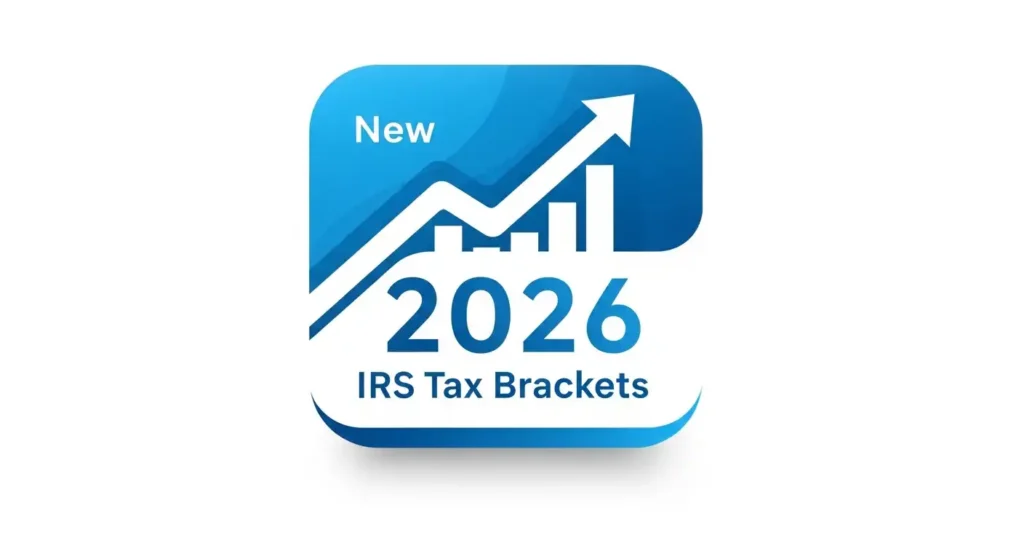
New 2026 IRS Tax Brackets & Major Tax Law Changes
The upcoming 2026 federal income tax season is shaped by two major forces: modest inflation adjustments announced by the IRS and the sweeping permanence brought by the "One Big Beautiful Bill Act" (OBBBA). This landmark legislation made the Tax Cuts and Jobs Act (TCJA) provisions permanent, preventing a massive tax hike for millions. For tax year 2026, you'll see updated income thresholds for all seven tax brackets, an increased standard deduction, and several new, temporary deductions that could significantly impact your tax planning. Understanding these changes, including the crucial new rules for the SALT deduction and estate taxes, is essential for effective financial strategy in 2026 and beyond.
TL;DR: 2026 Tax Landscape in Focus
The federal tax landscape for tax year 2026 is defined by stability and targeted adjustments. The "One Big Beautiful Bill Act" (OBBBA) made the lower tax rates from the 2017 TCJA permanent, preventing a widespread tax increase. On October 9, 2025, the IRS codified the annual inflation adjustments for 2026, which reflect a moderate inflation rate of approximately 2.7%. These adjustments provide modest relief from "bracket creep." Key strategic shifts include a temporary quadrupling of the SALT deduction cap to $40,000, new temporary deductions for seniors and workers with tipped or overtime income, and a permanent increase in the federal estate tax exemption to $15 million per individual. These changes create new opportunities and complexities in tax planning, especially around itemization and income management.
In This Article:
- The Legislative Bedrock: Understanding OBBBA
- The Inflation Adjustment Mechanism
- Analysis of 2026 Federal Income Tax Brackets and Rates
- The Standard Deduction vs. Itemization
- New and Expanded Deductions: Targeted Relief
- Key Credits and the Alternative Minimum Tax (AMT)
- Provisions for Wealth Transfer, Investment, and International Filers
- Adjustments to Health and Retirement Savings Plans
- Economic Context and Strategic Outlook
The Legislative Bedrock: Understanding the "One Big Beautiful Bill Act" (OBBBA)
To fully appreciate the tax environment of 2026, it is essential to understand the alternative scenario that was averted. Without the passage of the OBBBA, the individual income tax provisions of the 2017 Tax Cuts and Jobs Act (TCJA) were scheduled to expire on December 31, 2025. This would have triggered a reversion to the pre-TCJA tax code, resulting in a substantial tax increase for most American households.
Averting the "Fiscal Cliff": Visualizing the Averted Tax Hike
Under the projected pre-TCJA law for 2026, the tax system would have reverted to higher rates and narrower brackets. The standard deduction would have been drastically reduced, while the personal exemption would have returned. The Child Tax Credit would have been halved, with much lower income phase-outs. The confluence of these changes would have resulted in higher tax liability for an estimated 62% of tax filers. The following visuals illustrate the significant tax changes that were avoided thanks to the OBBBA.
The TCJA Expiration Timeline That Was Avoided
Lower Rates & Higher Standard Deduction under TCJA
TCJA Provisions Were Set to Expire
Higher Rates & Lower Standard Deduction Would Have Returned
Projected Standard Deduction Reduction
The standard deduction would have been nearly cut in half, subjecting more income to tax for the majority of taxpayers who do not itemize.
Projected vs. Actual Tax Rate Changes
This chart shows the jump in marginal tax rates that would have occurred versus the stable rates secured by the OBBBA.
OBBBA's Core Mandate: Permanence and Stability
The primary achievement of the OBBBA was to make the TCJA's individual income tax framework permanent. By keeping the seven-bracket structure and lower marginal rates intact, the legislation provides a stable and predictable foundation for the tax code. This legislative action, however, comes with fiscal implications, projected to add approximately $3.1 trillion to the federal deficit over the next decade. This stability removes significant uncertainty, allowing financial planners and taxpayers to build stable, long-range forecasts for retirement, education savings, and wealth transfer with a much higher degree of confidence.
The Inflation Adjustment Mechanism: A Closer Look at the Chained CPI-U
The annual adjustments to tax parameters are determined by a specific inflation metric: the Chained Consumer Price Index for All Urban Consumers (C-CPI-U). This metric is designed to be a more accurate measure of cost-of-living changes than the traditional CPI-U because it accounts for "consumer substitution"—the tendency for people to alter their purchasing habits in response to price changes.
Because it accounts for this substitution effect, the C-CPI-U generally reports a lower rate of inflation than the traditional CPI-U. For the 2026 tax year, the inflation adjustment is approximately 2.7%. While the annual adjustment process is intended to prevent bracket creep, the mandated use of the slower-growing C-CPI-U creates a subtle, long-term increase in the real tax burden over time, a form of "stealth tax."
Analysis of 2026 Federal Income Tax Brackets and Rates
The IRS has officially published the inflation-adjusted federal income tax brackets for tax year 2026. The seven marginal tax rates—10%, 12%, 22%, 24%, 32%, 35%, and 37%—remain unchanged. However, the income thresholds for each bracket have been adjusted upward by approximately 2.7% to account for inflation. A notable nuance within the 2026 adjustments is a provision from the OBBBA that provides an extra bit of inflation adjustment for the two lowest tax brackets, delivering targeted relief to lower- and middle-income households.
| Tax Rate | Filing Status | 2025 Taxable Income Thresholds | 2026 Taxable Income Thresholds |
|---|---|---|---|
| 10% | Single | $0 to $11,925 | $0 to $12,400 |
| 10% | Married Filing Jointly | $0 to $23,850 | $0 to $24,800 |
| 10% | Married Filing Separately | $0 to $11,925 | $0 to $12,400 |
| 10% | Head of Household | $0 to $17,000 | $0 to $17,700 |
| 12% | Single | $11,926 to $48,475 | $12,401 to $50,400 |
| 12% | Married Filing Jointly | $23,851 to $96,950 | $24,801 to $100,800 |
| 12% | Married Filing Separately | $11,926 to $48,475 | $12,401 to $50,400 |
| 12% | Head of Household | $17,001 to $64,850 | $17,701 to $67,450 |
| 22% | Single | $48,476 to $103,350 | $50,401 to $105,700 |
| 22% | Married Filing Jointly | $96,951 to $206,700 | $100,801 to $211,400 |
| 22% | Married Filing Separately | $48,476 to $103,350 | $50,401 to $105,700 |
| 22% | Head of Household | $64,851 to $103,350 | $67,451 to $105,700 |
| 24% | Single | $103,351 to $197,300 | $105,701 to $201,775 |
| 24% | Married Filing Jointly | $206,701 to $394,600 | $211,401 to $403,550 |
| 24% | Married Filing Separately | $103,351 to $197,300 | $105,701 to $201,775 |
| 24% | Head of Household | $103,351 to $197,300 | $105,701 to $201,750 |
| 32% | Single | $197,301 to $250,525 | $201,776 to $256,225 |
| 32% | Married Filing Jointly | $394,601 to $501,050 | $403,551 to $512,450 |
| 32% | Married Filing Separately | $197,301 to $250,525 | $201,776 to $256,225 |
| 32% | Head of Household | $197,301 to $250,500 | $201,751 to $256,200 |
| 35% | Single | $250,526 to $626,350 | $256,226 to $640,600 |
| 35% | Married Filing Jointly | $501,051 to $751,600 | $512,451 to $768,700 |
| 35% | Married Filing Separately | $250,526 to $375,800 | $256,226 to $384,350 |
| 35% | Head of Household | $250,501 to $626,350 | $256,201 to $640,600 |
| 37% | Single | $626,351 or more | $640,601 or more |
| 37% | Married Filing Jointly | $751,601 or more | $768,701 or more |
| 37% | Married Filing Separately | $375,801 or more | $384,351 or more |
| 37% | Head of Household | $626,351 or more | $640,601 or more |
The Standard Deduction vs. Itemization: A Renewed Strategic Crossroads
Following the annual inflation adjustment, the standard deduction amounts for tax year 2026 have increased. However, key provisions within the OBBBA have created a renewed strategic crossroads, making the analysis of whether to itemize a critical component of tax planning once again.
The 2026 Standard Deduction
- Married Couples Filing Jointly & Surviving Spouses: $32,200
- Single Filers & Married Filing Separately: $16,100
- Heads of Household: $24,150
Taxpayers age 65 or older or who are blind are entitled to an additional standard deduction amount.
The SALT Deduction Game-Changer
The most significant factor reviving itemization is a temporary OBBBA provision that quadruples the cap on the State and Local Tax (SALT) deduction from $10,000 to $40,000 for tax years 2026 through 2029. This change, which primarily benefits those in high-tax states, is subject to an income-based phase-out for incomes above $500,000 for joint filers. This temporary increase creates a powerful incentive for "deduction bunching"—accelerating deductible expenses into the 2026-2029 window to maximize tax benefits.
New and Expanded Deductions: Targeted Relief and Planning Complexities
The OBBBA introduces several new, temporary deductions for specific groups, but they come with strict income limitations, elevating the importance of managing income levels. According to the IRS newsroom, these provisions are effective for tax years 2025 through 2028.
| Deduction Type | Maximum Deduction Amount | MAGI Phase-Out Begins |
|---|---|---|
| Senior Bonus | $6,000 (Single) / $12,000 (Joint) | $75,000 (Single) / $150,000 (Joint) |
| Tipped Income | $25,000 | $150,000 (Single) / $300,000 (Joint) |
| Overtime Pay | $12,500 (Single) / $25,000 (Joint) | $150,000 (Single) / $300,000 (Joint) |
The introduction of these valuable but tightly-phased deductions makes the active management of Modified Adjusted Gross Income (MAGI) a central element of tax planning for many taxpayers.
Key Credits and the Alternative Minimum Tax (AMT)
The 2026 tax code includes inflation adjustments to several critical tax credits and the AMT parameters.
- Earned Income Tax Credit (EITC): The maximum credit for a taxpayer with three or more children will be $8,231.
- Child Tax Credit (CTC): The OBBBA indexes the credit to inflation starting in 2026, ensuring its real value does not erode over time.
- Employer-Provided Childcare Credit: This business credit is massively expanded, with the maximum credit limit jumping from $150,000 to $500,000 (or more for small businesses) and the credit rate increasing from 25% to 40% or more.
- Alternative Minimum Tax (AMT): The exemption amounts are increased to $90,100 for unmarried individuals and $140,200 for married couples filing jointly, shielding more taxpayers from this tax.
Provisions for Wealth Transfer, Investment, and International Filers
The 2026 tax code includes important updates for capital gains, estate and gift taxes, and foreign earned income.
Federal Estate & Gift Tax
Perhaps one of the most consequential long-term provisions of the OBBBA is the permanent increase of the federal estate tax basic exclusion amount to $15,000,000 per individual. A married couple can now shield up to $30 million from federal estate taxes, and this amount will be indexed for inflation. This change marks a "great simplification" of estate planning for most affluent families, shifting the focus from complex tax avoidance to more direct legacy and succession goals.
Other Key Provisions
- Long-Term Capital Gains: The preferential rates of 0%, 15%, and 20% are maintained, with inflation-adjusted income thresholds.
- Annual Gift Exclusions: The annual gift tax exclusion remains unchanged at $19,000 per recipient.
- Foreign Earned Income Exclusion: The maximum exclusion amount increases to $132,900.
Adjustments to Health and Retirement Savings Plans
Inflation adjustments also affect contributions for popular tax-advantaged health plans.
- Health Flexible Spending Arrangements (FSAs): The maximum employee contribution increases to $3,400. If the plan permits, the maximum carryover amount will be $680.
- Health Savings Accounts (HSAs): For family coverage with a high-deductible health plan (HDHP), the minimum annual deductible will be $5,850, and the maximum annual out-of-pocket expense limit will be $10,700.
Economic Context and Strategic Outlook for 2026 and Beyond
The tax changes for 2026 are being implemented in a macroeconomic environment of moderating economic activity and normalizing inflation. The permanence of the TCJA's framework provides long-term planning stability, but the temporary nature of key provisions like the enhanced SALT deduction cap and the new bonus deductions creates a critical, time-limited window of opportunity. Active management of MAGI and strategic use of "deduction bunching" will be key strategies. Proactive, multi-year planning is essential to maximize benefits and prepare for the tax environment after these temporary provisions expire. Tools like the Tax Foundation's interactive tax calculator can be valuable for illustrating the impact of these changes.
Wondering How State Taxes and Cost of Living Affect Your Bottom Line?
Your federal tax bill is only part of the story. Use our powerful calculator to see how your finances stack up in different states across the U.S.
Calculate Your State Cost of LivingDisclaimer: The content provided on this webpage is for informational purposes only and is not intended to be a substitute for professional advice. While we strive to ensure the accuracy and timeliness of the information presented here, the details may change over time or vary in different jurisdictions. Therefore, we do not guarantee the completeness, reliability, or absolute accuracy of this information. The information on this page should not be used as a basis for making legal, financial, or any other key decisions. We strongly advise consulting with a qualified professional or expert in the relevant field for specific advice, guidance, or services. By using this webpage, you acknowledge that the information is offered “as is” and that we are not liable for any errors, omissions, or inaccuracies in the content, nor for any actions taken based on the information provided. We shall not be held liable for any direct, indirect, incidental, consequential, or punitive damages arising out of your access to, use of, or reliance on any content on this page.
About The Author

Roger Wood
With a Baccalaureate of Science and advanced studies in business, Roger has successfully managed businesses across five continents. His extensive global experience and strategic insights contribute significantly to the success of TimeTrex. His expertise and dedication ensure we deliver top-notch solutions to our clients around the world.
Time To Clock-In
Start your 30-day free trial!
Experience the Ultimate Workforce Solution and Revolutionize Your Business Today
- Eliminate Errors
- Simple & Easy To Use
- Real-time Reporting

Saving businesses time and money through better workforce management since 2003.
Copyright © 2025 TimeTrex. All Rights Reserved.
